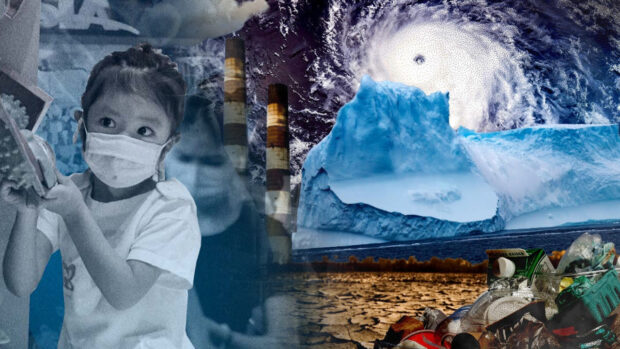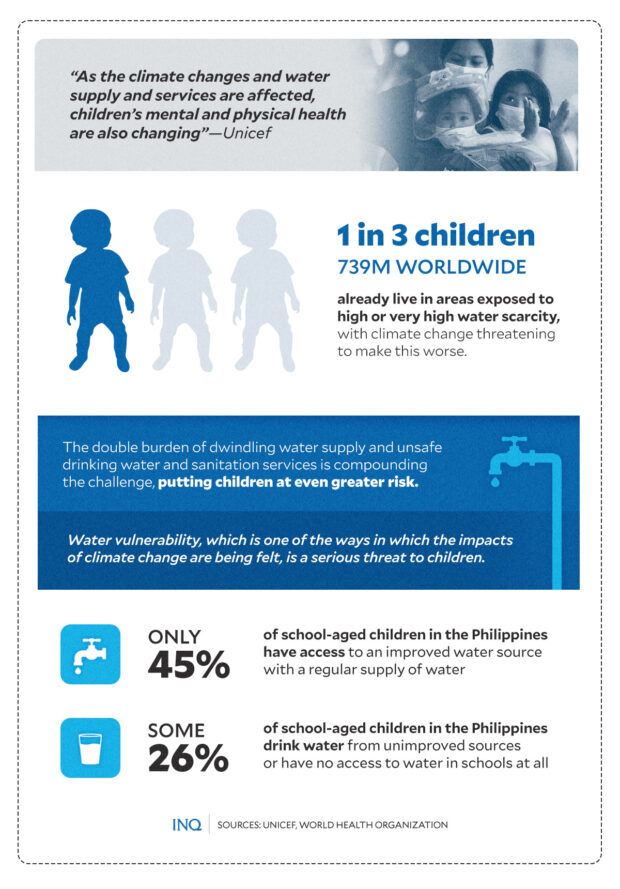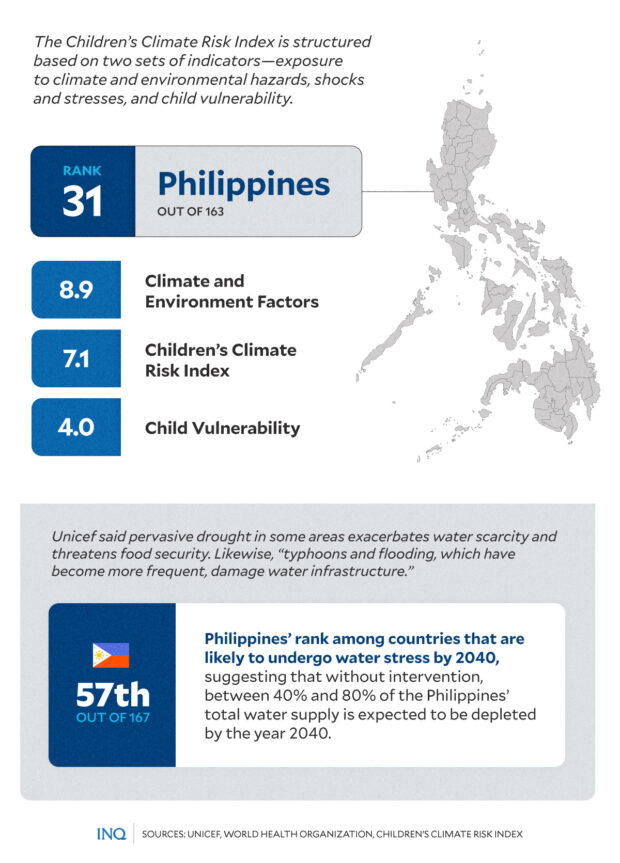Climate change, no longer a distant threat, is hurting kids now
MANILA, Philippines—The average temperature in the Philippines is expected to rise by 1.8 C in 2050, but the Philippine Atmospheric, Geophysical and Astronomical Services Administration (Pagasa) stressed that climate change is already happening—that it is no longer a distant threat, it is already the reality.
Pagasa pointed out that current warming has increasingly posed serious challenges to people and the environment, and will continue to do so in the years to come, saying that its adverse effects are already being seen and may intensify extremely over time, especially if nothing is done to lessen emissions of greenhouse gases.
A column for the INQUIRER once stated that while it may be hard to think of climate change when joblessness is rising and poverty is worsening, “we all have to concern ourselves with it now because it is no longer just some vague realm of scientists and world leaders.” It has already become a problem, “one that’s already hurting all of us,” especially the poor.
READ: Climate change and the common Filipino
But based on a new report by the United Nations Children’s Fund (Unicef), the way climate change is altering the mental and physical health of children is seriously concerning, too, with Oyunsaikhan Dendevnorov, its representative to the Philippines, stressing that “children are demanding change, but their needs are far too often relegated to the sidelines.”
Article continues after this advertisementAs the Copernicus Climate Change Service revealed, global temperatures reached record high levels in 2023, making it the “warmest year on record” with an average of 14.98 C, 0.17 C higher than in 2016. It said, too, that last year was 0.60 C warmer than the 1991 to 2020 average and 1.48 C warmer than the 1850 to 1900 pre-industrial level. It was the hottest year in centuries.
Article continues after this advertisementAn analysis by the National Aeronautics and Space Administration (NASA), pointed this out too, saying that Earth’s average surface temperature last year was the warmest on record, exceeding by 1.2 C the average for NASA’s baseline period of 1951 to 1980. “We are facing a climate crisis,” NASA administrator Bill Nelson said.
But with the El Niño this year, the UN said 2024 could even be warmer, with the United States National Oceanic and Atmospheric Administration predicting that there is a one in three chance that 2024 will be warmer in 2023 — and a 99 percent certainty that this year will be one of the five warmest years ever.
READ: El Niño could make 2024 hotter than record 2023
Little to no water
Unicef’s report, “The Climate-Changed Child,” released late last year, shed light on how climate change is threatening, or already impacting, children as a result of water scarcity and lack of access to safe drinking water services, which, Unicef said, are some of the ways in which the impacts of climate change are being felt.
It said one in three children, or 739 million worldwide, already live in areas exposed to high or very high water scarcity, with climate change threatening to make this worse. Likewise, the double burden of dwindling water availability and unsafe drinking water and sanitation services is compounding the challenge, putting children at even greater risk.
Then in the Philippines, Unicef pointed out that only 45 percent of school-aged children have access to an improved water source with a regular supply of water, while some 26 percent drink water from unimproved sources or have no access to water in schools at all, saying that pervasive drought in some areas “exacerbate[s] water scarcity.”
READ: Majority of Filipinos noticed climate change impacts in 2023, survey shows
“Typhoons and flooding, which have become more frequent, damage water infrastructure, [too],” it said.
Based on data from the British Geological Survey, groundwater is the source of over 50 percent potable water supply and 85 percent of piped water supply in the Philippines.
It said groundwater is strategically and economically important to current and future water supply “and is the principal source of dry season river flows,” which are used for drinking water, too.
A 2015 study by the World Resources Institute likewise pointed out that the Philippines may experience more severe water scarcity in 2040.
The Department of Environment and Natural Resources had pointed out that as early as 1996, monitoring of the Philippines’ rivers showed that only 51 percent of the classified rivers still met the standards for their most beneficial use. The rest were already polluted, especially by domestic wastewater.
“Yet, only three percent of investments in water supply and sanitation were going to sanitation and sewage treatment,” it said.
Children at high risk
As stressed by Unicef, the bodies and minds of children are uniquely vulnerable to the impacts of climate change: “As the climate changes and water supply and services are affected, children’s mental and physical health are also changing.”
READ: PH youth, most vulnerable to climate change, also most active in fighting crisis
READ: Winning the war vs climate change
“From the moment of conception until they grow into adulthood, the health and development of children’s brains, lungs, immune systems, and other critical functions are affected by the environment they grow up in,” it said.
Unicef pointed out that in the Philippines most especially, child malnutrition is worsened by crop failures and rising food prices, which is exacerbated by higher temperatures and increased rainfall linked to climate change.
“The bodies and minds of children in the Philippines are vulnerable to polluted air, poor nutrition, and extreme heat. Their world is changing and so too is their well-being as climate change affects their mental and physical health,” Dendevnorov said.
Based on the Children’s Climate Risk Index, which is structured with two indicators—exposure to climate and environmental hazards, shocks and stresses, and child vulnerability—the Philippines, with a score of 7.1, was 36th out of 163 countries, indicating that children in the Philippines are confronted with the stark reality of being at high risk of climate change.



